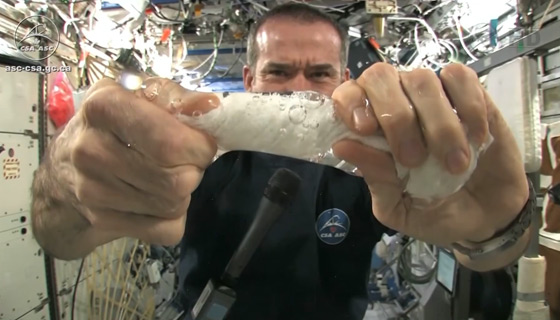Weekly Science Picks

At the top of my list this week would have to be the ISS Commander Chris Hadfield from Canadian Space Agency wringing out a wet towel in zero gravity. If you haven’t watched it yet. Do it now.
The explanation behind what happens is more in depth than “magic”. Cmdr Hadfield is right when he mentions surface tension of water. Though it doesn’t explain the chemistry and physics of what is happening and also why he wasn’t worried about the exposed electronics in the ISS. I have to admit I was worried about droplets of water travelling out and into the wiring because water molecules are attracted to one another due to its molecular structure. I should have realised this being a chemist and all.
The arrangement of oxygen and hydrogen of water results in a slightly positively charged area and a negatively charged area so water molecules arrange themselves where opposites attract. This even holds in zero gravity.
What I especially like about Cmdr Hadfield is that he includes people on Earth in his daily routine on the ISS. He replies to people’s tweets. I personally got a kick when he retweeted one of my tweets. Real time communication with an astronaut on the ISS. That’s awesome. He also includes school students allowing them to ask him questions. If you’re on Twitter and he isn’t someone you’re following, go find him at @Cmdr_Hadfield.
At the end of this week, a news story broke of how radioactive bacteria could potentially used to treat metastatic pancreatic cancer, that is where the cancer has spread to other parts of the body. The bacteria used was Listeria monocytogenes which is a member of a bacterial family that can cause serious infections and health complications. The good news though is that immune system normally gets rid of Listeria.
One reason why tumours grow is that they suppress the immune system so scientists thought to exploit this hoping that introduced Listeria would concentrate in tumour sites and deliver targeted radiotherapy. They introduced Listeria bacteria dosed with radioisotopes in mice with pancreatic cancer.
The results are really promising. The mice that received this treatment had 90% fewer cancer tumours in other areas of the body than those who had received radiotherapy and saline. The original cancer in the pancreas though was unaffected. It’s early days and it’s a long way from human trials. There is still the need to explain what was observed in this trial and what remains unknown is the effect of radiation on healthy organs.
Pancreatic cancer is the 6th highest cause of death for all cancer types in Australia, and only about 6% of people with this cancer survive 5 years after diagnosis compared to a 5-year survival of 88% for breast cancer, 93% for thyroid cancer and 19% for lung cancer. Currently there are very few treatment options available.
Lum M (2013-04-28 00:08:02). Weekly Science Picks. Australian Science. Retrieved: Dec 18, 2025, from http://ozscience.com/space/weekly-science-picks-28/
 Follow
Follow